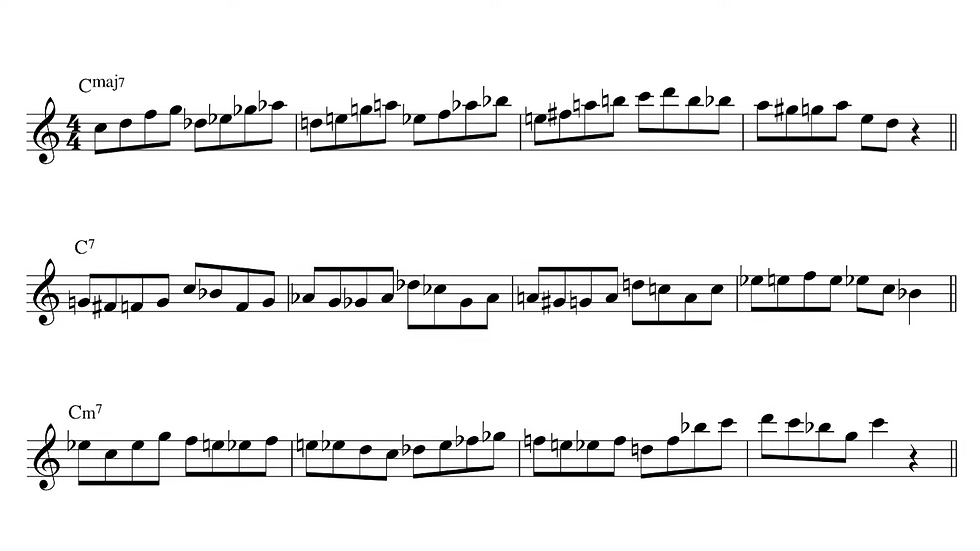5 Steps to Mastering Modern Lines
- Jazz Lesson Videos

- May 1, 2023
- 4 min read
Looking for a way to spice up your lines a bit? Or do you feel like you’re stuck playing scales? Today we’re going to go from scales to cells, with no mitochondria required—don’t worry, this isn’t biology class.
A melodic cell is a group of notes—the easiest way to use cells is to take a group of four notes and treat them like a building block, moving them around and combining them with other blocks. So when you hear a big extended line that sounds super impressive, remember that it’s really a bunch of cells put together.

This is a topic that Chad LB has covered in depth in the Jazz Gym, and it’s a really great technique for modern jazz musicians to master. We’ll look at five steps you can take to master modern lines so that you can incorporate cells into your next solo.
Be sure to check out the Jazz Gym—it’s a subscription where you can access live video workouts every day. There are coaching sessions to guide you through the practice session, and every day of classes has three different blocks with three different “workout” options. These options are designed to cater to whatever level you’re at—we have developing improvisers as well as professionals and educators who are looking to go the extra mile to improve their playing. Each week, we have a focus concept to help you dial in on improving a specific aspect of your playing—some weeks have focused on melodic cells! If you’re looking to level up your playing, you’ll definitely want to check out the Jazz Gym.
You can also check out our Modern Combo package to get our Modern Phrases, Modern Etudes, and Melodic Cells PDF packages bundled together for a self-guided way to master melodic cells.
Contents
Diatonic cells
Jumping right in, we have the easiest cell concept to grasp—diatonic cells. As the name implies, these cells fit within a single key/scale. Eventually you may want to use these diatonic cells in a chromatic way by taking them up and down all 12 keys.
Let’s start by building a cell—using 1, 2, 3, and 5. You’ll recognize this cell from our blog on John Coltrane’s “Giant Steps.” These four notes fit nicely into a major pentatonic sound and are very flexible.
If we take the 1, 2, 3, 5 cell and move it up and down chromatically, here’s what that would look like.
Chromatic and non-diatonic cells
Naturally after diatonic cells, we come to non-diatonic cells. These cells are going to use a combination of notes that don’t sit inside a conventional scale. These cells are non-scalar and are used all over modern jazz. Here’s what that looks like.
Compound cells
Once you’ve got some diatonic and chromatic cells under your belt, you’ll want to put them together into compound cells. This is where you put together one diatonic and one non-diatonic cell into a larger cell, which you can then move up and down chromatically. Once you’ve started using compound cells, it starts to become clearer how these can be used as a real phrase that you can incorporate in your solos.
In this example, you’ll see that you step down a couple of half steps, then jump up a fourth. After that, you return to the starting note of that last cell and do another cell that ends up being diatonic.
Melodic cell streams
Once you’ve got compound cells down, you’ll move onto what we call melodic cell streams. This is where you take individual cells back to back continuously to structure a whole phrase. Melodic cells offer us a good way to create tension and release outside of a standard ii-V-I sound.
Something that Chad LB likes to do is start with a cell that fits inside a chord, then you can play a bunch of cells outside of the harmony and come back inside at the end.
For this phrase, we’ll use the 1, 2, 3, 5 shape for the first two measures inside of C major. Then we go up half steps for two bars straight, but what you’ll see happens in the second bar is we mix up the order of the notes in the 1, 2, 3, 5 cell. That way, instead of playing 1, 2, 3, 5, we’ll play 5, 3, 1, 2 in D major and 1, 2, 5, 3 in E-flat major.
When you’re improvising through this type of material, it’s not like you actually have to be thinking about this on the fly—once you get flexible enough with playing lots of melodic cells, you’ll start to play them somewhat naturally and know where to throw them in.
On measure 3, you’ll see that chromatic scale that we did earlier starting from B, then a diatonic cell using 3, 1, 2, 3 and a resolution that fits inside of C major.
Melodic cells on jazz standards
Now let’s check out how you can apply this concept to a jazz standard. We’re going to check out some changes from a tune we’ll call “All The Things That Are,” so these changes will probably look familiar to you.
What you’ll see is that that a bunch of cells weave in and out of the harmony, so pay close attention to the rhyming shapes—meaning that if you look at bars 11 and 12, you’ll see two compound melodic cells back to back, moving chromatically, creating tension and release through the chords.
Here’s the first 16 bars of this etude.
That’s all for today, but make sure to check out our melodic cell PDF packages for practice integrating these concepts into your playing. And if you’re really looking to take your playing to the next level, the Jazz Gym is a great way to keep yourself accountable with a daily routine of guided learning sessions.
We’ll see you next time!














Comments